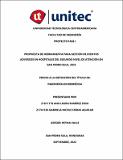JavaScript is disabled for your browser. Some features of this site may not work without it.
Mostrar el registro sencillo del ítem
Propuesta de herramienta para gestión de eventos adversos en hospitales del segundo nivel de atención en San Pedro Sula, 2022
| dc.contributor.advisor | Reyna Elizabeth Valle Ordoñez | es_ES |
| dc.contributor.author | Ana Laura Ramírez Sosa | es_ES |
| dc.contributor.author | Gabriela Nicole Cribas Aguilar | es_ES |
| dc.date.accessioned | 30/03/23 12:04 | |
| dc.date.available | 2023-03-30T18:04:16Z | |
| dc.date.issued | 01/09/2022 | |
| dc.identifier.uri | https://repositorio.unitec.edu/xmlui/handle/123456789/12470 | |
| dc.description.abstract | Al ser una creación del ser humano, la tecnología médica ha evolucionado con el tiempo y mejorado exponencialmente. Sin embargo, ésta presenta riesgos que pueden perjudicar a pacientes como a usuarios. Por medio del enfoque mixto se desarrolló un esquema investigativo, en donde se realizó entrevistas, observaciones y análisis de estadísticos. Logrando identificar que, el 84% del personal de enfermería en los hospitales estudiados no han presenciado ningún caso de evento adverso causados por equipos médicos a lo largo de su desempeño laboral al igual que, el 100% de ingenieros biomédicos en estos hospitales, siendo una respuesta poco confiable debido a razones como la falta de mantenimiento preventivo en dispositivos médicos, la carencia de capacitaciones, las limitaciones de presupuesto y personal en estos hospitales, haciendo que, la probabilidad de que exista un error no intencional de parte del usuario al momento de estar brindándole atención sanitaria a un paciente sea alta, provocando la existencia de eventos adversos. Así mismo, se determinó que, el 27% de la muestra ha sentido limitantes al querer realizar un reporte de evento adverso, teniendo como principal obstáculo el no poder localizar rápidamente a los entes encargados. Por otra parte, el 100% de los Ingenieros Biomédicos en las tres instituciones estudiadas, determinaron que es importante contar con una herramienta de registro de dicha información. Con base en lo antes mencionado, a partir del análisis de los resultados se destacó la importancia de proponer una herramienta que ayude a recopilar reportes de fallos y eventos adversos causados por equipo médico en los hospitales de San Pedro Sula, la cual fue creada con base en las características y necesidades encontradas, garantizando la notificación oportuna de sucesos importantes relacionados con los equipos médicos en especial los eventos adversos que pueden dañar la salud de las personas. Palabras clave: Evento adverso, fallos, gestión de la información, sistema de notificación, tecnología médica, tecnovigilancia. | es_ES |
| dc.format | es_ES | |
| dc.language | Español | es_ES |
| dc.language.iso | es-HN | es_ES |
| dc.publisher | Universidad Tecnológica Centroamericana UNITEC | es_ES |
| dc.rights | Attribution-NonCommercial-ShareAlike 3.0 United States | * |
| dc.rights.uri | http://creativecommons.org/licenses/by-nc-sa/3.0/us/ | * |
| dc.source | Universidad Tecnológica Centroamericana UNITEC | es_ES |
| dc.subject | Equipos médicos | es_ES |
| dc.subject | Tecnología médica | es_ES |
| dc.subject | Evento adverso | es_ES |
| dc.title | Propuesta de herramienta para gestión de eventos adversos en hospitales del segundo nivel de atención en San Pedro Sula, 2022 | es_ES |
| dc.type | Working Paper | es_ES |
| dc.description.abstractenglish | As a human creation, medical technology has evolved over time and improved exponentially. However, it presents risks that can harm both patients and users. By means of a mixed approach, a research scheme was developed, where interviews, observations and statistical analysis were carried out. It was possible to identify that 84% of the nursing personnel in the hospitals studied have not witnessed any case of adverse event caused by medical equipment throughout their work performance, as well as 100% of biomedical engineers in these hospitals, being an unreliable response due to reasons such as the lack of preventive maintenance in medical devices, lack of training, budget and personnel limitations in these hospitals, making the probability of an unintentional error on the part of the user when providing health care to a patient high, causing the existence of adverse events. Likewise, it was determined that 27% of the sample has felt limitations when wanting to report an adverse event, having as main obstacle the inability to quickly locate the entities in charge. On the other hand, 100% of the Biomedical Engineers in the three institutions studied determined that it is important to have a tool for recording this information. Based on the above, the analysis of the results highlighted the importance of proposing a tool to help compile reports of failures and adverse events caused by medical equipment in the hospitals of San Pedro Sula, which was created based on the characteristics and needs found, guaranteeing the timely notification of important events related to medical equipment, especially adverse events that can damage people's health. Key words: Adverse event, failures, information management, medical technology, , notification system, techno vigilance. | es_ES |
| dc.coverage | San Pedro Sula, Cortés, Honduras | es_ES |
| dc.catalogador | Dennis Cálix | es_ES |
| dc.faculty | Facultad de Ingeniería | es_ES |
| dc.thesis.degreename | Ingeniería en Biomédica | es_ES |
| dc.codigocarrera | I-10 | es_ES |
| dc.thesis.degreelevel | Pregrado | es_ES |
| dc.discipline | Ingeniería y TI / Engineering & IT | es_ES |
| dc.ddc | 610.737 | es_ES |
| dc.campus | UNITEC | es_ES |
| dc.collection | Trabajo de Investigación | es_ES |
| dc.date.terna | 2022-09-01 |
Ficheros en el ítem
Este ítem aparece en la(s) siguiente(s) colección(ones)
Excepto si se señala otra cosa, la licencia del ítem se describe como Attribution-NonCommercial-ShareAlike 3.0 United States



